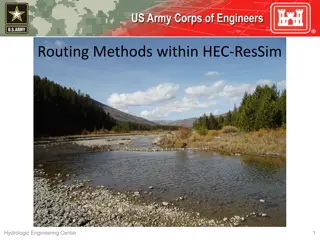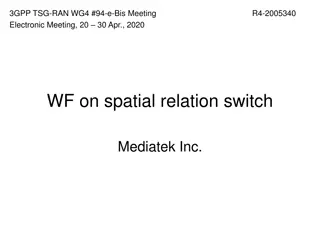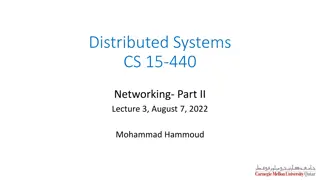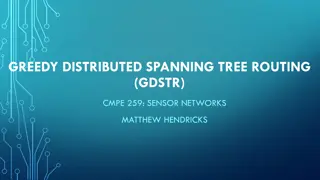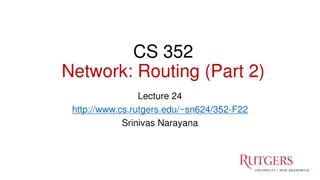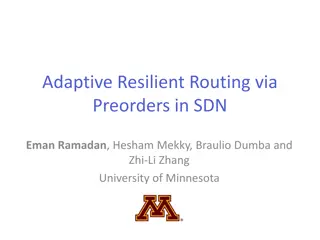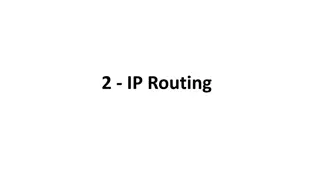Switching, routing, and flow control
Fundamentals of network architecture, including switching, routing, and flow control. Learn how packets are switched, routed, and controlled to ensure efficient data transmission. Discover the differences between packet switching and cut-through switching, as well as various routing variations like cut-through routing and wormhole routing.
Download Presentation

Please find below an Image/Link to download the presentation.
The content on the website is provided AS IS for your information and personal use only. It may not be sold, licensed, or shared on other websites without obtaining consent from the author.If you encounter any issues during the download, it is possible that the publisher has removed the file from their server.
You are allowed to download the files provided on this website for personal or commercial use, subject to the condition that they are used lawfully. All files are the property of their respective owners.
The content on the website is provided AS IS for your information and personal use only. It may not be sold, licensed, or shared on other websites without obtaining consent from the author.
E N D
Presentation Transcript
Network architecture Topology (what): how to connect the nodes with links? Routing (which): which path a packet will go through? Switching (how): how a packet goes through a path (routers)? Flow control (when): when can a packet go through a router?
Switching How a packet/message passes a switch Traditional switching mechanisms Packet switching Messages are chopped into packets, each packet is switched independently. E.g. Ethernet packet: 64-1500 bytes. The switching happens after the whole packet is in the input buffer of a switch. Store-and-forward Circuit switching The circuit is set up first (the connection between the input and output ports alone the whole path are set up). No routing delay Too much start-up overheads, no suitable for high performance communication. Packet switching for computer communications and circuit switching for telephone communications.
Packet switching Store-and-Forward o A switch waits for the full packet to arrive before sending it to the next switch o Application: LAN (Ethernet), WAN (Internet routers) Drawback: packet latency is proportional to the number of hops (links). o Let each link has bandwidth b and latency L. Let the packet size be p and the path length be H for a packet. The packet latency is H(p/b + L), proportional to H. o Latency is not scalable!
Cut-through switching Packet is further cut into flits. o Flit size is very small, e.g. 4 bytes, 8 bytes, etc. o A packet will have one header flit, and many data flits. A switch examines the header flit and forward the message before the whole packet arrives. Packet H F F F F T Pipeline in the unit of flits. Header Flit Tail Flit Flits Application: most high-end switches (InfiniBand, slingshot, also used in all supercomputers).
Packet switching versus cut-through switching Time = H (p/b + L) Time = n/b + H L (fix: p/b + H L) When L is small, the time is independent of the hop count. o Latency scalability
Cut-through routing variations Cut through routing: when the header of a message is blocked, the whole message will continue until it is buffered in the blocked router. Need to be able to buffer multiple packets High buffer requirement in routers Eventually, the buffer will be filled up. Wormhole routing Cut through routing with buffer for only one flit for each channel Minimum buffer requirement Each channel has the flow control mechanism - when the buffer is used, signal sender to not send anything until the buffer is cleared. When the header is blocked, the message stop moving (the message may be buffered in a distributed manner, occupying buffers in multiple routers).
Contention and link level flow control Two messages try to use the same outgoing link o One needs to either buffer one message, drop one message, or misroute one message. Wormhole networks try to block in place: link-level flow control. o A message may occupy multiple links. o Cut through routing has the same effect when more data are in the network. This kind of networks are also call lossless networks (as compared to lossy network) o No packet is ever dropped by the network. o Is the Internet lossless? Which one is better, lossy or lossless network?
Head-of-line blocking If the header flit cannot move due to contention, other worms may not be able to proceed even when the link (channel) is idle. Link idle Red cannot proceed due to head of line blocking Buffer full, blue blocked by orange
Virtual channel If each link has only one head , head-of-line blocking will be a big problem. Maintaining multiple buffers (virtual channels) for each link alleviates the head of line blocking problem. Virtual channel basically virtualizes the link and can be used to solve other problems such as deadlock. William Dally, Virtual Channel Flow Control , TPDS, 1992.
Lossless network and tree saturation Lossless networks have very different congestion behavior from lossy networks such as the Internet In a lossy networks, congestion is limited to a small region. In a lossless network with cut-through or wormhole routing, congestion will spread to the whole network. Messages that do not use the congested link may also be blocked. This is known as tree saturation. The congested link is the root of the tree.
Tree saturation example 001->000 111->000 blocked
Tree saturation 001->000 111->000 011->001 110->001 Not directly go through the congested link, but blocked.
Tree saturation Tree saturation can happen in any topology
Lossless network and deadlock WORMHOLE ROUTING: HOLD ON TO THE BUFFER WHEN BLOCKED. HOLD AND WAIT THIS IS THE FORMULA FOR DEADLOCK. SOLUTION?
Virtual channels alleviate the deadlock problem A logical channel can be realized with one buffer and the related flow control mechanism. At one time, one message use the link. We can allow multiple messages to share the link by having multiple virtual channels: Each virtual channel has one buffer with the related flow control mechanism. The switch can use some scheduling algorithm to select flits in different buffer for forwarding. With virtual channel, the train slows down, but not stops when there is network contention.
Deadlock avoidance Layered routing o No loop in each virtual channel Routing to avoid forming loops Increase virtual channel ID every time a packet passes a link (works for low dimensional topology).
Routing Once the topology is fixed, routing determines the path from the source to the destination. Why routing matters? Consider an 8-node ring with two routing schemes, shortest path routing and random routing. Evaluating the performance of an interconnect often uses some well known communication patterns. 1 2 3 4 5 6 7 0
Common traffic patterns used in interconnect evaluation Derived from applications Important to stress test the network with different patterns For each topology and pattern, one can derive the average hop count (latency) and maximum link load (throughput). Random uniform: each packet has a randomly selected source and/or destination. Random permutation: Each node is a source and a destination in this pattern. Special permutations: oBit reversal: oBit complement: oTornado:
Common traffic patterns Bit reversal: o Example (8 nodes), 0 000 2(010),3(011) Bit complement: o Example: 0(000) 5 101 ,3(011) Tornado: node i send to node (i + (N-1)/2) mod N o Example: 0 3,1 4,2 5,3 6,4 7,5 0,6 1,7 2 0,1 001 4 100 ,2(010) 5(101). 6(110),5(101) 7 111 ,1 001 4(100) 6 110 ,2 010
Analyzing the routing performance with the Tornado pattern in the 8-node ring topology: average hop count 1 2 3 4 5 6 7 0 Shortest path routing: average hop count = 3 Random routing: same direction hop count = 3, the other direction, hop count = 5. Average hop count = (3+5)/2 = 4
Analyzing the routing performance with the Tornado pattern in the 8-node ring topology: maximum link load 1 2 3 4 5 6 7 0 Shortest path routing: maximum link load = 3 (throughput = 1/3) o Channel on the other direction is not used! Random routing: Each packet will pick the direction randomly. goes clockwise, goes counter-clockwise. Clockwise link load = 3/2, counter-clockwise link load = 5/2. Throughput = (1/(5/2))=0.4
Routing classification: how to select path How to select among the set of all possible paths from a source to a destination oDeterministic: Always choose the same route Example: shortest path routing in ring Restrictive, but can be easily implemented oOblivious: Choose the route without considering the current network state information Example: random routing on ring Deterministic is a special oblivious routing oAdaptive: Choose the route based on the network state based on congestion metrics: link buffer occupancy, history of link load
Routing classification: path length Minimal routing: always use shortest path o Example: shortest path routing on ring Non-minimal routing: may use non-shortest path o Example: random routing on ring
Routing classification: routing mechanism Source routing: message include a list of intermediate nodes (or ports) toward the destination. Intermediate routers just lookup and forward. A source routed packet format is as follows: Destination based routing: message only includes the destination address. Intermediate routers use the address to compute the output port (e.g. dest addr as an index to the forwarding table). What is the routing used in the Internet?
Dimension order routing in a mesh/torus X Y Routing: Always go X first then Y o Minimal and deterministic, deadlock free (no loop) o Not take advantage of the path diversity in the topology, poor load balancing DC DA DB SA SB SC
Dimension order routing in a mesh/torus What about randomly goes XY or YX o Minimal and deterministic o Better load balancing. Need additional mechanism to resolve deadlock DC DA DB SA SB SC
Valiants routing algorithm How: Randomly select an intermediate node I, route packet from s to I and then from I to d. I d Randomizes any traffic pattern o All patterns become like random uniform o Balance network load Non-minimal routing, high latency. s No communication locality any more
Valiants routing for Tornado pattern on the 8-node ring 1 2 3 4 5 6 7 0 1/8 traffic 1/16 traffic Both phases are random uniform. Let us look at each phase. For random uniform, all links will have the same load in the ring. Let us look at the link from 3 to 4. Traffic in 3->7 can go either clockwise or counter-clockwise, so count half in one direction. Load for one phase = 6/8 + 4/16 = 1. Total load = 2 and throughput = 0.5.
Adaptive routing Can be minimal or non-minimal Uses network state to make routing decisions o Buffer occupancies are often used o Local information readily available Global information more costly to obtain With flow control, backpressure can imply global congestion (with delay) Network state changes rapidly. Using local information leads to sub-optimal results.
Local information may result in sub-optimal choice d Low load link Median load link High load link s
Non-minimal adaptive routing Potentially use more resources. Low performance under high load d Low load link Median load link High load link s
Mechanism to sense remote congestion: backpressure 1 2 3 4 5 6 7 0 3->7 have two potential equal length paths Initially 3->7 chooses the clockwise path. 5-> 6 is already ongoing. Link 3- >4 does not sense congestion at the beginning. Since 5->6 cannot handle the load, packet buffer builds up at node 5. When it is full, it will not accept packets, and eventually buffer in node 4 will be full. Then buffer at node 3 will be full and 3 can sense the congestion. This is called backpressure. Backpressure allows local queue length to reflect remote congestion.
Deadlock free routing Make sure that the loop can never occur Put constraints on how paths can be used to route traffic. Use infinite virtual channels. Deadlock free routing example: Up/down routing Select a root node and build a spanning tree Links are classified as up links or down links Up links: from lower level to upper level Down links: from upper level to lower level Link between nodes in the same level: up/down based on node number Path: all up link, all down link, a sequence of up links followed by a sequence of down links No up link can follow a down link. Why deadlock free? Can we have disconnected nodes?
Deadlock free routing Is X-Y routing on mesh deadlock free? How about adaptive routing on mesh that always use the shortest paths?







